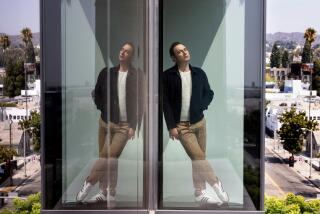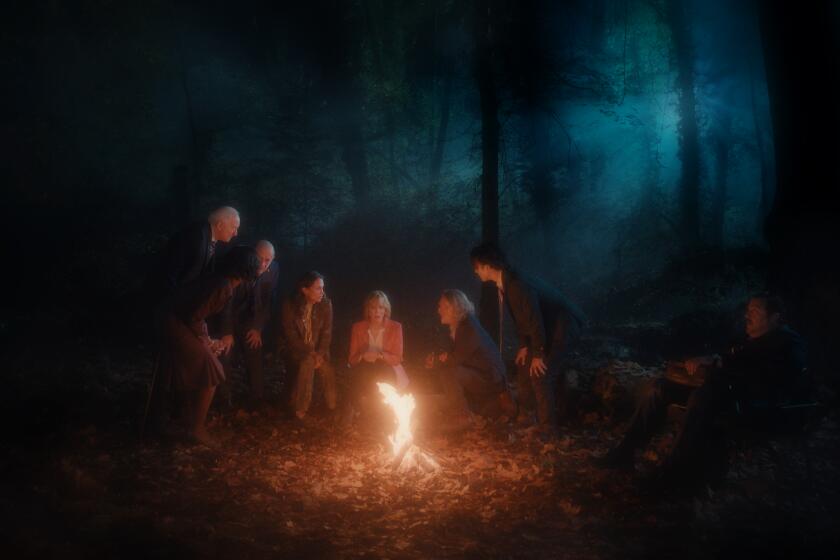A mitzvah in its 25th year
“We killed the audience.” Ruth Seymour couldn’t help thinking that as the KCRW general manager faced dead phone lines during the first live broadcast of her annual Hanukkah show in 1979.
Back then, KCRW-FM (89.9) was a tiny public radio station with a staff of five and a constant scramble for new programming, not the National Public Radio powerhouse it is today.
The BBC Drama Service provided plenty of Christmas shows but nothing for Hanukkah, so Seymour decided to create and host her own show.
Armed with a stack of records found at stores in the Fairfax district, Seymour presented Yiddish folk music, a memorial to the Holocaust, a short story by one of the great Yiddish authors, and songs from the 2nd Avenue Hit Parade -- the Yiddish music halls.
The show ran four hours, during which time the phone lines at the station fell eerily silent. During the short story, two calls finally came in from Yiddish teachers, but that was it. Seymour still sounds amazed at the memory. “Now, it’s a small place, and our audience is small too, but still.” She thought nobody was listening.
Then the show ended. And the phone lines exploded. Calls came in for three hours straight. The staff finally had to leave the office to get away from the phones.
So a one-time attempt to celebrate Hanukkah and Yiddish culture has become an annual KCRW tradition. The 25th edition of “Philosophers, Fiddlers and Fools” will air today at noon, in advance of the start of Hanukkah at sunset tonight.
The title speaks to Yiddish archetypes as well as Seymour’s penchant for alliteration. The show has been pared down to three hours, but the format otherwise hasn’t changed much. CDs have replaced records, and the Web has helped immensely in her search for new material, but Seymour still hosts the show alone, live.
And she always refuses to tape the program for sale or rebroadcast, a decision that has been the source of much displeasure among some fans of the show.
Seymour explained that “as a memorial to the Holocaust, it was always intended to be ephemeral.” Displaying some of the tenacity so familiar to KCRW listeners, Seymour has held fast to that decision over the years.
However, thanks to the Web, ephemeral isn’t quite what it used to be. Oddly, Seymour doesn’t mind the show’s availability online. Maybe now people will stop hocking her chinik (literal translation: banging her teakettle; figurative translation: hectoring her) for copies.
Seymour knows plenty about getting her way. Whether squeezing one extra donation out of listeners at pledge drive times (the next one starts Jan. 30) or getting the interests of her little station recognized by the pooh-bahs at NPR, Seymour is a commanding presence in the public radio arena.
*
A deeply personal show
She stage manages interviews, dismissing questions she finds irrelevant (about her friendship with Isaac Bashevis Singer, or about the ramifications of a $200-million bequest Joan Kroc left to NPR in her will) with the same decisiveness that she uses in running her station. No wonder she’s turned it into NPR’s West Coast flagship.
But if listeners assume she’s all business, “Philosophers, Fiddlers and Fools” is a yearly exercise that, among other things, reveals her softer side. The show is a deeply personal experience for Seymour, who considers herself a secular Jew. Now in her 60s, she grew up in the Bronx learning Yiddish every day after her regular school classes. She continued studying in college with the renowned Yiddish scholar Max Weinreich.
As Seymour has related on a past program, she once revealed to Weinreich her worries that when she left her studies and went out into the world, there wouldn’t be anybody left speaking the language. “And he said to me, ‘Yiddish is magic. It will outwit history.’ ”
The magic has touched KCRW listeners. As the holidays roll around, people start calling the station, asking the volunteers when “her Hanukkah show” is going to air.
“I will tell you one of the most moving stories, which I’ve never told on the air because I break up when I tell it,” Seymour said. “The mother of one of my programmers worked in the Jewish Home for the Aged, and she knew about the Hanukkah show. The first year she worked there, she gathered together the people who lived there, and they all listened to the show together.
“And when I got to the part where I played ‘Never Say That You Are Going on the Last Road’ -- which is the anthem, if you will, of the Jewish resistance during the Second World War, it’s called Zog Nit Keinmol, it’s very famous -- her mother said there were men in wheelchairs who stood up, it had that kind of effect.” Sure enough, she grew teary at the recollection.
*
Rising interest in Yiddish
It isn’t just Jewish listeners who are tuning in, either. One woman wrote in to tell Seymour that she regularly waits until the show airs to decorate her Christmas tree.
For the 25th anniversary, Seymour wanted to offer something really special. So in addition to such treats as Sophie Tucker singing “My Yiddishe Mama,” Seymour managed to secure the rights to a recently translated story by Singer that appeared in the New Yorker in September.
Titled “Androgynous,” the story is remarkably topical in its exploration of gender and sexuality issues in relation to religious beliefs. It also has all the sensibilities common to Yiddish literature -- irony, wit, anger, compassion. The story is read by Theodore Bikel, the voice that launched a thousand Tevyes.
The show’s popularity over the past 25 years mirrors a growing interest in Yiddish in the larger society. Asks Seymour: “Who would have believed 25 years ago, when this program began, that there would be organizations in which kids in their 20s today want to learn the language?”
The L.A. organization Yiddishkayt puts on a Yiddish festival every other year. Yiddish classes are offered everywhere from UCLA to Berlin. Seymour is astonished by “the growth of this dead language -- it’s coming back to life again.” Just as professor Weinreich predicted.
Every year Seymour asks herself why she has to do the show again. “If you’ve been doing it that long, you feel like you have a gun to your head.” But then she runs into a listener who tells her how meaningful the program is. So she continues to find new ways to bring the joy, the liveliness and the sorrow of a vanished world to a grateful audience. Mostly grateful, anyway. “The other wonderful comment that I get is: ‘So why only once a year?’ ”
More to Read
The biggest entertainment stories
Get our big stories about Hollywood, film, television, music, arts, culture and more right in your inbox as soon as they publish.
You may occasionally receive promotional content from the Los Angeles Times.










